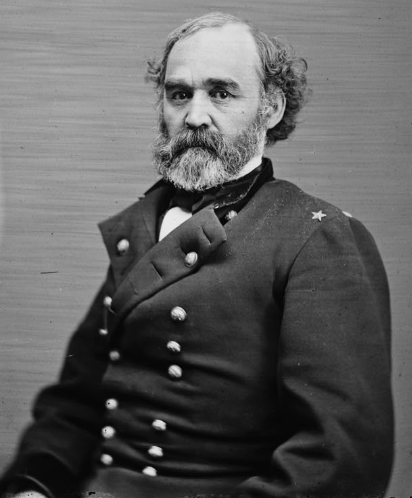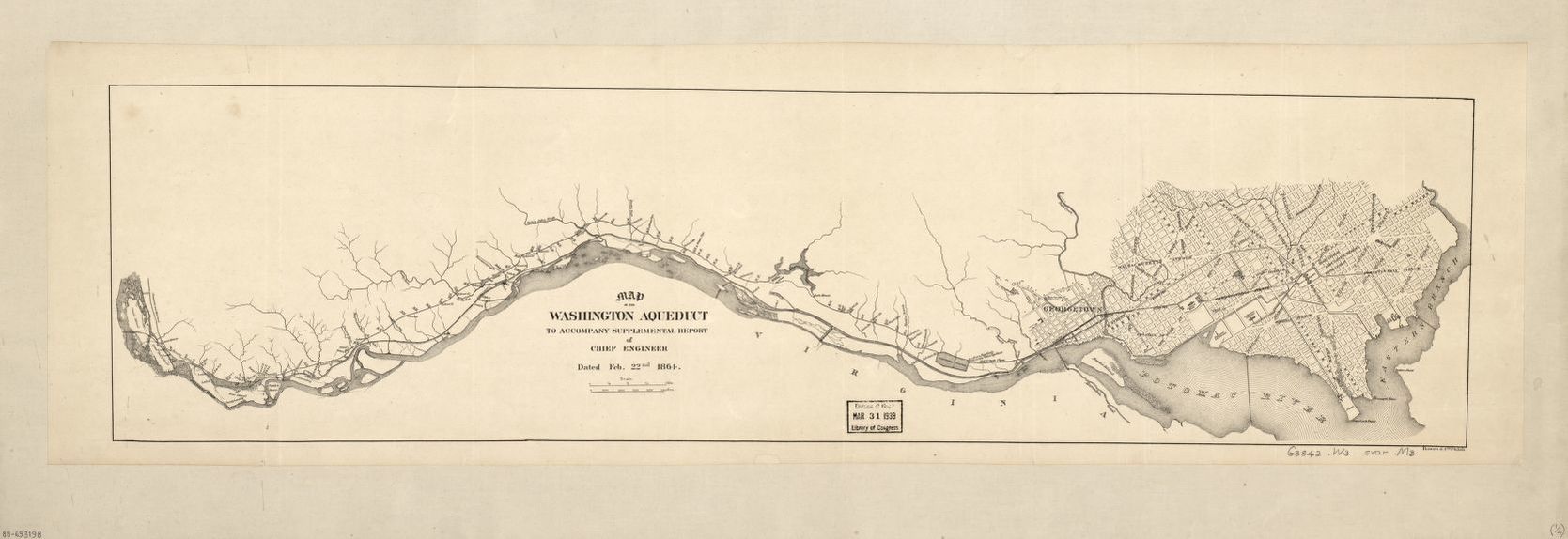For nearly 170 years, the Washington Aqueduct, a division of Baltimore District, has provided potable drinking water for the District of Columbia, later expanding coverage to Virginia’s Arlington and Fairfax Counties in 1927 and 1947, respectively. The federally owned and operated public water supply agency currently produces an average of 155 million gallons of water per day between two water treatment plants to meet regional demands, which amounts to less than half of their combined capacity of 320 million gallons per day. This production ensures that approximately one million citizens living in, working in, or visiting the area, including many critical government and military facilities, can access safe water and remain fully operable – a vastly different landscape from the late 1800s when Congress realized that a municipal water system was essential in order to meet the demands of rapid population growth.

The history of the Aqueduct is as rich as that of its local region. Commissioned in 1852 following a large fire the year before that nearly engulfed the entire Capitol building, construction commenced in 1853 under supervision of Corps of Engineers Lieutenant Montgomery C. Meigs. This undertaking was one of the earliest U.S. military involvements in the civil sector.
Prior to construction, Meigs reported to Congress on water supply and identified the Potomac River at Great Falls as an ideal water source. His report covered water requirements such as storage, filtering, fire service and sanitation, as well as present and future city populations – important predictions given that water systems develop with the growth of a city.
Despite his best efforts, Meigs failed to foresee the city’s future water requirements. He estimated 22.5 million gallons of water would be needed per day in the year 1900, and the capacity of his suggested 9-foot conduit from Great Falls would not be exceeded for almost two centuries. Capacity was reached within less than one-third of that time. It quickly became clear that the Aqueduct would have to be willing to grow and change along with the city that surrounds it to properly meet demands.
The Aqueduct’s mission is unwavering. Despite a booming population and modern-day water requirements, the skilled team of approximately 150 people continues to produce safe drinking water around the clock. And yet, the organization’s rich tradition of adaptation is once again being put to the test as it faces many of the same readiness challenges that are impacting aging water systems throughout the country.
America’s aging water infrastructure
Aging water infrastructure is at a crossroads nationwide. In a 2018 survey and assessment, the Environmental Protection Agency (EPA) found that drinking water infrastructure alone needed nearly $500 billion in maintenance and improvements over the next 20 years to continue to provide safe and reliable service. The industry is also grappling with emerging problems such as water safety challenges, the deployment of new technology, and the inevitable need to address climate resiliency and water scarcity.
While many of the nation's water systems are working diligently to modernize toward greater infrastructure sustainability, local and federal funding for drinking water infrastructure has not kept pace with the industry’s growing needs. Water and wastewater utilities are notoriously difficult to fund compared to other more visible aging infrastructure initiatives, given that system assets are most often buried or hidden from the public eye. These factors have resulted in a gap between the amount of spending needed for critical updates and money available to support those needs.
The Washington Aqueduct is no exception. Readiness challenges mirror those seen throughout the industry. Subsequently, the organization is undertaking its most robust modernization effort to date – an evolution necessary to ensure continued success for a vital mission.

Ushering in a new era of modernization
Under the direction of Baltimore District Commander Col. Estee S. Pinchasin and Washington Aqueduct General Manager Rudy Chow, the Aqueduct is several years into an evolutionary, mission-essential modernization plan that will usher in a new era for the historic water utility. The plan, or Evolution 2030, centers around an intensive asset management strategy, as well as data system upgrades that will result in critical infrastructure renewal, improved water security, and ensured continuity for the Aqueduct.
“I am excited to help usher in such a momentous period of change for the Washington Aqueduct,” said Pinchasin. “The award-winning team of highly skilled professionals at the Aqueduct are committed to improving the processes that will ensure we will continue to provide safe, reliable and cost-effective drinking water to the region.”
A major portion of the modernization efforts centers around the acquisition and implementation of comprehensive asset management practices that will enable planning for the “three R’s”: rehabilitation, renewal, and replacement. This will integrate Operations and Maintenance (O&M) and Capital Improvement Program (CIP) to enable strategic investment planning, funding and regulatory requirements. Ongoing CIP efforts include maintenance and improvement efforts to the Aqueduct’s 2nd and 3rd High Reservoirs that will result in improved function and increased protection and reliability, including demolition and replacement of the affluent and effluent control buildings; replacement of water sampling systems and control valves; and upgrades to reservoir drain lines. The Dalecarlia Water Treatment Plant’s (WTP) clearwells and backwash water tank will also be receiving significant improvements that will result in improved function, increased protection, and reliability of the overall system.
D.C. locals may have noticed another improvement project as they drive down MacArthur Boulevard - the iconic Castle Gatehouse, built in 1900 to resemble the castle emblem of the U.S. Army Corps of Engineers, is undergoing renovation, along with four other structures at the Georgetown Reservoir currently receiving architectural, structural, electrical, mechanical and civil upgrades.
Other ongoing repairs and upgrades include replacement of the McMillan North Clearwell, improvements to flocculation and sedimentation systems at the Dalecarlia WTP, and repairs to deteriorated sections of the old conduit located under MacArthur Boulevard, which convey water from the Potomac River to Dalecarlia. Future projects include major upgrades to the East Filter Building at the Dalecarlia WTP; improvements to transmission mains that will address main leaks and replace critical valves to ensure reliable water service to respective service areas; and chemical building HVAC upgrades.
Additionally, a major employee relocation of the administration building is also in the works with a goal of providing improved workspace accommodations to meet staffing needs and make the entire space ADA compliant. These improvements will make way for future staff growth and development, another major priority for the Aqueduct leadership team.
“We strive to be a national leader in the water treatment and supply industry,” said Chow. “Hiring and retaining experienced, qualified and talented people is a primary focus of ours throughout this modernization effort.”
Pinchasin agrees.
“The current efforts to modernize this vital organization are not only limited to infrastructure. We also have to grow the engineers of the future who will operate, maintain and expand this operation for decades to come. The right people are just as critical to the mission as our infrastructure needs. They are the glue of an optimized organization.”
The second major portion of ongoing modernization efforts focus around system data upgrades. Overdue technological upgrades to digital water monitoring systems will provide consistent automated and predictive data analysis and improve control of system operators throughout the Aqueduct. They will also enable for real-time problem identification, including physical and cyber security systems that are necessary in modern-day operations. Upon its completion, the Aqueduct will have a state-of-the-art security system that will help deter, detect, and deny unauthorized access as well as provide staff the ability to remotely assess situations and respond to incidents at critical infrastructure facilities.
Other major forward-planning considerations for the Aqueduct include climate change and source water resiliency planning. The Potomac River serves as the sole source of raw water for the region, and U.S. Geological Survey climate models project rising temperatures in the Potomac River Basin, which may shift water availability. The EPA, which sets all standards and requirements for drinking water, also reports that climate change is likely to increase water demand while shrinking water supplies.
“The wide range of possible changes in water availability increase uncertainty in water supply planning and require continual study of action to help us improve system performance and long-term resiliency planning,” said Pinchasin. “We cannot afford to overlook this issue as we look towards an Aqueduct that is prepared to keep the water running for many decades to come. I am confident that this team, along with our Wholesale Customer Board, wholesale customers, and other important stakeholders, will remain committed to moving this mission forward successfully despite the challenges that may come with modernization efforts. We will work diligently to keep the water flowing.”